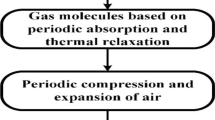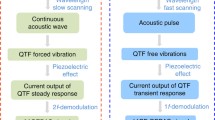Abstract
An improved quartz-enhanced photoacoustic spectroscopy (QEPAS) sensing system for trace gas detection is proposed. The optical fiber Fabry–Perot (F–P) demodulation method is used to replace the conventional electrical one in the QEPAS system. The experimental QEPAS system, which has a microresonator consisting of two stainless steel tubes with a length of 2.3 mm and an inner diameter of 0.9 mm, is implemented to detect the absorption of water vapor in the open environment. The structure parameters of the quartz tuning fork (QTF) are optimized in order to make the sensing system work more stably and reliably. Demonstration experiments are carried out. The vibration signal of the QTF was picked up by the optical fiber F–P demodulator and the conventional electrical scheme at the same time. Normalized noise equivalent absorption coefficients of \(4.05\times 10^{-7}\,\text{ cm}^{-1}~{\cdot }~\mathrm{W}~{\cdot }~{\text{ Hz}}^{-1/2}\) and \(2.40\times 10^{-6}\,\text{ cm}^{-1}~{\cdot }~\mathrm{W}~{\cdot }~{\text{ Hz}}^{-1/2 }\) are obtained, respectively. The experimental result demonstrates that the sensitivity of the improved QEPAS sensing system with an optical fiber F–P demodulator is about 5.9 times higher than that of the conventional QEPAS system.



Similar content being viewed by others
Abbreviations
- \(\triangle L\) :
-
Vibration amplitude of QTF
- \(L\) :
-
Initial cavity length
- \(\lambda \) :
-
Wavelength of the probe light source
- \(R_{1}\) :
-
Reflectivity at the end face of fiber
- \(R_{2}\) :
-
Reflectivity at the end face of the QTF side surface
- \(I\) :
-
Interference light intensity
- \(V_{0}\) :
-
Maximum piezoelectric voltage
- \(R_{0}\) :
-
Resistance of the QTF
- \(I_{0}\) :
-
Piezoelectric current
- \(I^{\prime }\) :
-
Differential of \(I\) at a center time \(t_{0}\)
- \(S\) :
-
Photoacoustic signal intensity
- \(\kappa \) :
-
Constant for system parameters
- \(\alpha \) :
-
Absorption coefficient per unit concentration of the target species
- \(C\) :
-
Concentration of the trace gas species
- \(P\) :
-
Excitation laser power delivered to the QTF
- \(\xi \) :
-
Conversion efficiency from light to acoustic signal.
- NNEA:
-
Normalized noise equivalent absorption coefficient
- \(\alpha _{{\min }}\) :
-
Minimum detectable absorption coefficient for SNR = 1
- \(B\) :
-
Measurement bandwidth
- \(\rho _{x}\) :
-
Detectivity of gas \(x\) of interest
- \(S\) :
-
Line intensity
- \(g(\nu )\) :
-
Lineshape function
- \(N_\mathrm{a}\) :
-
Avogadro constant
- \(p\) :
-
Gas pressure
- \(T\) :
-
Absolute temperature
- \(R\) :
-
Molar gas constant, \(8.314\,\text{ J}~{\cdot }~\text{ mol}^{-1}~{\cdot }~\text{ K}^{-1}\)
References
A.G. Bell, Am. J. Sci. 20, 305 (1880)
A.A. Kosterev, Y.A. Bakhirkin, R.F. Curl, F.K. Tittel, Opt. Lett. 27, 1902 (2002)
A.A. Kosterev, F.K. Tittel, Appl. Opt. 43, 6213 (2004)
G. Wysocki, A.A. Kosterev, F.K. Tittel, Appl. Phys. B 85, 301 (2006)
W.X. Zhao, X.M. Gao, K. Liu, F.J.M. Harren, W.D. Chen, F.K. Tittel, in Lasers and Electro-Optics, 2008 and 2008 Conference on Quantum Electronics and Laser Science, San Jose, CA, 2008, pp. 1, 2
H.M. Yi, K. Liu, W.D. Chen, T. Tan, L. Wang, X.M. Gao, Opt. Lett. 36, 481 (2011)
M. Horstjann, Y.A. Bakhirkin, A.A. Kosterev, R.F. Curl, F.K. Tittel, Appl. Phys. B 79, 799 (2004)
A.A. Kosterev, Y.A. Bakhirkin, F.K. Tittel, Appl. Phys. B 80, 133 (2005)
R. Lewicki, G. Wysocki, A.A. Kosterev, F.K. Tittel, Appl. Phys. B 87, 157 (2007)
K. Liu, J. Li, L. Wang, T. Tan, W. Zhang, X. Gao, W. Chen, F.K. Tittel, Appl. Phys. B 97, 527 (2009)
A. Elia, C. Di Franco, V. Spagnolo, P.M. Lugarà, G. Scamarcio, Sensors 9, 2697 (2005)
Acknowledgments
This study was supported by the Fundamental Research funds for the Central Universities of China under Grant No. CDZR10120013.
Author information
Authors and Affiliations
Corresponding author
Appendix: Equations
Appendix: Equations
The relationship between the vibration amplitude of QTF and the light intensity detected by F–P can be expressed as
where L is the initial cavity length and \(R_{1}, R_{2}\) are the reflectivities.
The maximum piezoelectric voltage \(V(t)\) generated by the deflection of the QTF is
where \(\beta \) is the effective piezoelectric coupling coefficient, \(R_{0}\) is the resistance of the QTF, and \(I^{\prime }(t_{0})\) is the differential of \(I(t)\) at \(t_{0}.\)
The photoacoustic signal intensity to the optical absorption in QEPAS can be expressed by the following equation:
where \(\kappa \) is a constant describing system parameters, \(\alpha \) is the absorption coefficient per unit concentration of the target trace gas species, C is the concentration of the target trace gas species, P is the excitation laser power delivered to the QTF, and \(\xi \) is the conversion efficiency from light to the acoustic signal.
where \(\alpha _{\min }\) is the minimum detectable absorption coefficient at SNR = 1, \(P\) is the optical power, B is the measurement bandwidth, and
where \(\rho _{x}\) is the detectivity of gas x of interest, S is the line intensity, \(g(\nu )\) is the line shape function, \(N_\mathrm{a}\) is the Avogadro constant, p is the gas pressure, T is the absolute temperature, and R is the molar gas constant, \(8.314\,\text{ J}~{\cdot }~\text{ mol}^{-1}~{\cdot }~\text{ K}^{-1}.\)
Rights and permissions
About this article
Cite this article
Lin, C., Zhu, Y., Wei, W. et al. A Novel QEPAS with Microresonator in the Open Environment. Int J Thermophys 34, 1413–1420 (2013). https://doi.org/10.1007/s10765-012-1375-x
Received:
Accepted:
Published:
Issue Date:
DOI: https://doi.org/10.1007/s10765-012-1375-x




